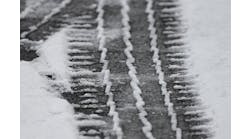When the snow finally stops and the ice begins to melt it is time to start
planning for next season's frozen onslaught and the snow conference is the
place to start. Sessions dealt with everything one may want to know about
fighting snow, covering such topics as avalanche control, deicers, snow
insurance and the latest techniques and strategies employed by various agencies
and municipalities in North America. They even had a session on how to handle
the media.
Deicing's popularity was apparent from the general-session panel discussion
devoted to it. Moderated by Tom Donohue from Minnesota's T2 Center, the
audience questioned the panel about their deicing concerns. Through these
questions they explained that the increased use in deicing chemicals and
salt is due to the public's growing demand for snow- and ice-free roads.
They explained how anti-icing-where chemicals are applied to a surface before
or during precipitation in order to prevent a bond between the ice and the
pavement surface-can result in a 30% to 50% decrease in deicing efforts.
They also addressed the use of sand and advised that before you decide on
using sand or a deicer you have to compare the cost of cleaning up the sand
to the cost the deicer will have on the infrastructure.
Guy Boston, with Street Operations in Edmonton, Alberta, Canada, and a member
of the panel, explained Edmonton's position on sand and deicers. The city
has a no-ice policy so they use calcium magnesium acetate (CMA), sodium
chloride (salt), and calcium chloride along with sand and rock chips to
control icing.
Other agencies shared their methods for dealing with snow. In a session
on winter maintenance strategies, Wayne Lupton, highway maintenance superintendent,
Colorado DOT (CDOT) discussed the highway-maintenance and snow-removal tactics
for Glenwood Canyon. Concerned for the environment in the Glenwood Canyon
area, CDOT is moving away from spreading sand and hopes to completely eliminate
its use. This will reduce PM10 emissions and prevent roadside clean-up of
the sand. At present CDOT is required to clean up all sand within 48 hours
of spreading it to prevent the sand from running off into the nearby Colorado
River.
They have decided to use liquid magnesium chloride (mag chloride) in anti-icing
efforts. It is a program which was started from scratch and is constantly
being improved upon. They spray 30 gal of magnesium chloride per lane mile
when only snow is falling, and 40 gal per lane mile when a rain and snow
mixture is coming down. The program has cut highway accidents by 40%, and
reduced labor per storm by 20%; however cost of snow removal has doubled.
Lupton emphasized the need to allow people to experiment with different
techniques to find a successful snow-removal system. For instance, they
are trying out double side-wings on plows and have continuously tweaked
and perfected their use of mag chloride sprayers.
Leo Clark, deputy commissioner for the Department of Streets and Sanitation
for Chicago conducted a session on how Chicago prepares for the snow season.
Chicago takes snow removal very seriously and does not tolerate failure.
Clark joked that commissioners and even the deputy commissioner will be
fired if their snow removal efforts are not successful. The people of the
city expect prompt removal of snow and in the past they voted a mayor out
of office over snow problems.
Clark stressed that snow removal is a 12-month job. It begins in the spring
with a review of last season's performance and continues through the summer
as new plans are laid, the program perfected and salt piles replenished.
Autumn, street sweeping also is an important part of the program. By cleaning
leaves from the gutters and sewers, melting snow can drain properly ensuring
that flooding and subsequent freezing will not occur.
Chicago is a salt town. They begin each winter with 350,000 tons even though
they fight their average 39 in. of snowfall with 200,000 to 250,000 tons.
The city stores nearly 200,000 tons of salt in salt domes and are planning
to build more so all salt can be stored indoors. They currently have the
largest salt dome in North America which holds 55,000 drums of salt, and
the city's dome at O'Hare International Airport is self-loading. But when
the temperatures get into the low 20s calcium chloride will be used to fight
the ice and snow. They also prewet some of the salt with calcium chloride
and they never use sand because of sewer-clogging problems.
In addition to the educational sessions, the 569 attendees had the opportunity
to preview products and equipment from 80 exhibitors. Odin Systems International,
Island Lake, Ill., had a booth where they answered questions and distributed
literature on its new Odin Bridge Sentry product. It is a portable, micro-processor
based system that monitors bridges to measure the approach of freezing conditions
and automatically controls chemical delivery for anti-icing. The product
is designed to eliminate the need for rolling stock in ice and snow control
on bridges.
Control Products Inc., Vancouver, Wash., is using GPS technology on its
thermal mapping system. The system consists of a fixed-base GPS station
and one or more rover stations, consisting of temperature sensors, radio
transceivers, satellite receivers and computer hardware and software. The
system helps monitor the temperature of a road surface at a precise point
and converts temperature, longitude and latitude to a radio frequency and
transmits these signals to the base station in order to streamline ice-fighting
techniques. Tyler Industries, who also had a booth at the show, is using
GPS to aid snow removal and is working with Virginia DOT to use the technology
in spreaders and plows.
Monroe Truck Equipment's new product is the Eliminator, a dual chain spreader with dump-body capability. The Monroe, Wis.-based company's product features a front spinner to allow spreading ahead of the drive tires where maximum traction is needed. It also allows for the spreading operations to take place with the body in the lowered position.

